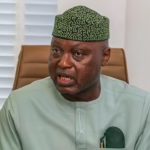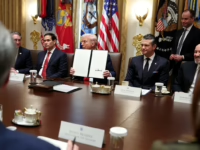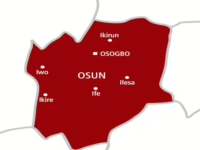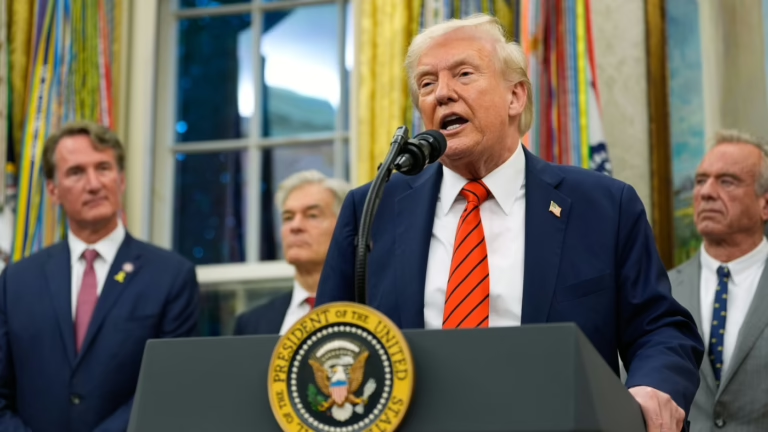President Donald Trump addresses the media in the White House Oval Office on October 10, 2025, in Washington, D.C., while Virginia Governor Glenn Youngkin, CMS Administrator Dr. Mehmet Oz, and HHS Secretary Robert F. Kennedy Jr. listen attentively.
Alex Brandon/AP
hide caption
toggle caption
Alex Brandon/AP
WASHINGTON – On Friday, President Donald Trump announced a potential escalation in trade tensions by threatening to impose a 100% tariff on imports from China, effective November 1 or possibly earlier. This move could push tariff rates to levels last seen in April, which had previously sparked concerns about a looming global economic downturn.
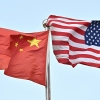
Expressing dissatisfaction with China’s recent export restrictions on rare earth minerals, Trump took to social media to question the necessity of his planned meeting with Chinese President Xi Jinping during his upcoming visit to South Korea. Despite this, he later clarified to reporters that the meeting had not been officially canceled, stating, “I’m going to be there regardless, so I would assume we might have it.”
He also left room for flexibility regarding the tariff threat, noting, “We’re going to have to see what happens. That’s why I made it Nov. 1.”
China’s New Export Controls
China recently tightened regulations on the export of rare earth elements, mandating that foreign companies obtain special permissions before shipping these critical materials abroad. Additionally, Beijing introduced licensing requirements for technologies involved in the mining, processing, and recycling of rare earths, explicitly denying export requests related to military applications.
Trump described these measures as unexpected and alarming, accusing China of adopting a hostile stance and effectively holding the global supply of essential metals and magnets-used in electronics, semiconductors, lasers, and aerospace technologies-hostage.
In a social media post, Trump declared that starting November 1, 2025, or sooner depending on China’s actions, the U.S. would impose an additional 100% tariff on Chinese goods, supplementing existing tariffs. He also announced plans to implement export controls on critical American software technologies in retaliation.
The Chinese Embassy in Washington has yet to issue a response to these developments.
Trump’s History of Leveraging Threats
The S&P 500 index dropped 2.7% amid investor concerns over escalating U.S.-China trade tensions, marking the steepest decline since April when similar tariff threats were last raised. Notably, the market closed before Trump detailed the specifics of his new tariff proposal.
This potential surge in import taxes, adding to the existing 30% tariffs on Chinese products, risks reigniting a trade war that could disrupt global economic growth, according to previous statements from the administration.
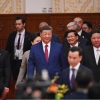
Despite the firm tone, Trump has a reputation for retreating from his threats. Earlier this year, some investors adopted what the Financial Times dubbed the “TACO” strategy-“Trump Always Chickens Out”-anticipating that tariff threats might not materialize fully.
However, imposing such steep tariffs now could exacerbate inflationary pressures amid a fragile labor market and growing concerns over a potential government shutdown, which has already led to federal worker layoffs.
The U.S. and China have been engaged in a tug-of-war over trade policies since the initial tariffs triggered a trade war earlier this year. Although both sides agreed to reduce tariffs following talks in Switzerland and the U.K., tensions persist, especially as China continues to limit U.S. access to rare earth minerals vital for numerous American technologies.
The backlog of export license applications from previous Chinese restrictions on rare earths remains significant, and the latest measures further complicate the global supply chain, according to the European Union Chamber of Commerce in China.
Additional points of contention include U.S. limits on Chinese imports of advanced semiconductors, disputes over American soybean sales, and reciprocal port fees imposed by both nations starting this week.
Experts See Room for De-escalation
While Trump has not officially canceled his meeting with Xi Jinping, he has cast doubt on its occurrence during his late-month Asia trip, which includes stops in Malaysia for the ASEAN summit, Japan, and South Korea for the Asia-Pacific Economic Cooperation meeting.
Sun Yun, director of the China program at the Stimson Center, interprets Beijing’s export restrictions as a response to recent U.S. sanctions on Chinese firms and the impending port fees targeting Chinese vessels. However, she believes there is still an opportunity to ease tensions and preserve the planned summit. “Beijing views de-escalation as a mutual process, and there is flexibility, especially regarding implementation,” she noted.
Gracelin Baskaran, who leads the Critical Minerals Security Program at the Center for Strategic and International Studies, emphasized China’s dominant position in the rare earth market, controlling 70% of mining and 93% of permanent magnet production-materials essential for high-tech industries and defense.
“These export restrictions not only hinder our industrial development at a critical time but also serve as a potent bargaining chip,” Baskaran explained.
Craig Singleton, senior director of the China program at the Foundation for Defense of Democracies, suggested that Trump’s announcement might signal the unraveling of the tariff truce that had previously eased trade tensions.
“The concept of mutually assured disruption is no longer theoretical,” Singleton remarked. “Both nations are simultaneously deploying economic countermeasures, with neither showing signs of retreat.”


